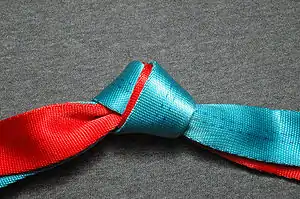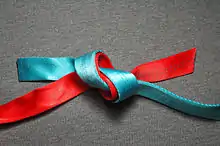| Water knot | |
|---|---|
 | |
| Names | Water knot, Tape knot, Ring bend, Grass knot, Overhand follow through |
| Category | bend |
| Typical use | To join webbing for climbing |
| Caveat | Ends should be left long, knot should be tightened and inspected before each use. Difficult to untie. |
| ABoK number | #296 |
The water knot (also tape knot, ring bend, grass knot, or overhand follow-through) is a knot frequently used in climbing for joining two ends of webbing together, for instance when making a sling.
Tying the water knot

It is tied by forming an overhand knot in one end and then following it with the other end, feeding in the opposite direction.
The ends should be left at least 3 inches![]()
Security
Testing has shown the water knot to slip very slightly, but very consistently, with each load and unload cycle. In tests using 9/16 in![]()
![]()
![]()
![]()